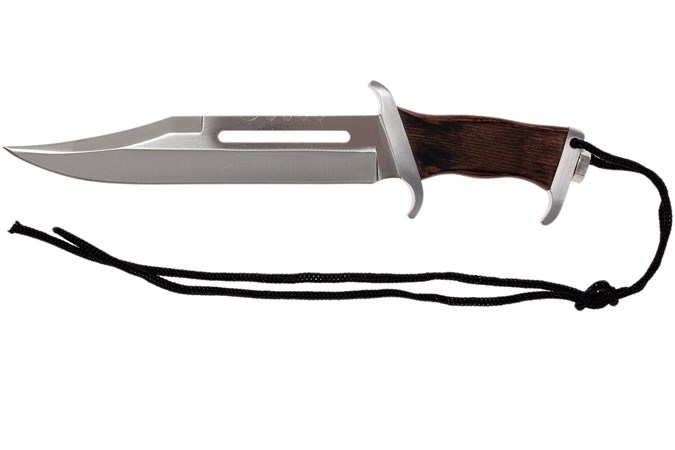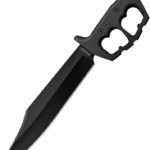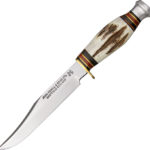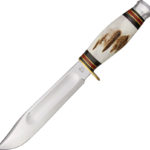What is Bowie Knife? as we all wonder with the word Bowie and what’s its association, how some full tang knives are called Bowie, what is the pronunciation of Bowie Knife and so on..! Following article is all about what is Bowie Knife and all said related questions. The information is gathered from different sources and is best as per our Knowledge. If there is anything quoted wrong please do let us know so we can update it accordingly.
The purpose of this article is to educate and provide information related to What is Bowie Knife?
You will see so many bowie Knives from different manufactures as you read along.
A Bowie knife “ˈbuːi” or “BOO-ee” is a type of fixed-blade battling knife developed by James Black in the early 19th century for Jim Bowie, who had actually ended up being popular for his usage of a large knife at a duel known as the Sandbar Fight.
Considering that the very first version, the Bowie knife has concerned include a number of recognizable and characteristic style features, although in typical usage the term describes any big sheath knife with a cross guard and a clip point.
There are 100s of customized knife makers producing Bowies and variations as it is still popular with collectors till date.
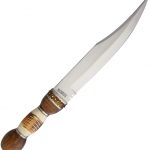
Marbles Knives Marbles Bowie (11.75″)
The early history of the Bowie knife is complicated by murky meanings, limited supporting paperwork, and conflicting claims. The Bowie knife is not well specified. By the mid-20th century most would consist of some mix of blade length and blade shape.
In the mid-19th century, when the appeal of the knife was at its peak, the term was used to a vast array of blades. Absent an agreement definition, it is difficult to clearly define the origin of the knife. To make complex matters, some American blades that fulfill the modern definition of the Bowie knife may pre-date Bowie.
Read more Review Marbles Folding Bowie Knife
Clashing Accounts of Bowie Knife History
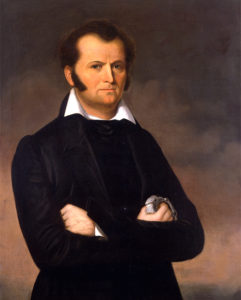
James Bowie
The Bowie knife derives part of its name and track record from, a well-known knife fighter, who passed away at the Alamo. James Bowie left an extremely thin paper path; in the absence of verifiable truths, his history was buried in unverifiable knife-fighting legend.
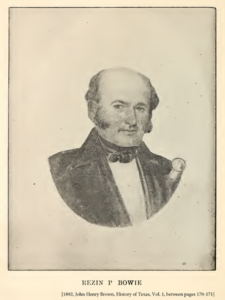
Rezin P Bowie
Historians seriously entertain the possibility that Bowie just battled one individual knife fight (which was not fought with a blade meeting the modern-day definition if Rezin Bowie’s account is true). That Sandbar Fight got nationwide promotion (accounts in Philadelphia, New York, and the Niles’ Register of Washington, D.C.) within months of the event. After Sandbar fight, James Bowie was seen wearing large knife.
Rezin Bowie
The Bowie household supplied a range of contrasting knife histories. James Bowie left absolutely nothing. His bro Rezin Bowie provided a terse history 2 years after James’ death. Sixteen years after James’ death someone (presumed to be James’ sibling John) a little changed Rezin’s description to consist of a blacksmith. Rezin’s grandchildren called a various blacksmith. A later Bowie claimed that the details attributed to John was a lie which John probably never ever saw the document, etc.
Bowie Knife & Book Authors
In the mid-20th century, a Bowie knife book author took liberties with the historical truths. Some files were exaggerated, some reported facts cannot be validated, and so on. Others integrated the mistakes into their accounts of both Bowie and his knives.
Without any solid meaning and clashing accounts of knife history, numerous were credited with the creation or enhancement of the blade.
To make complex matters, some American blades that satisfy the contemporary meaning of the Bowie knife might pre-date Bowie.
Historians seriously captivate the possibility that Bowie only combated one individual knife battle (and that was not battled with a blade fulfilling the contemporary meaning if Rezin Bowie‘s account is true). James Bowie plainly used a big knife after the Sandbar fight.
The Bowie household supplied a range of contrasting knife histories.
Descriptions of Historic Bowie Knife
The historic Bowie knife was not a single style, but was a series of knives improved several times by Jim Bowie for many years. The earliest such knife, made by Jesse Clift at Bowie’s brother Rezin’s demand resembled Spanish searching knives of the day, and varied little from a typical butcher knife. The blade, as later described by Rezin Bowie, was 1 1⁄2 in (3.8 cm) broad, 1⁄4 in (6.4 mm) thick and 9 1⁄2 in (24 cm) long. It was straight-backed, described by witnesses as a large knife with a simple riveted wood scale handle and having no clip-point nor any handguard.
Details from Bernard Levine about Bowie Knife
Bernard Levine has actually reported that the first recognized Bowie knife showed a strong Mediterranean impact insofar as basic lines were worried, particularly the shape of the conventional Spanish folding knife, then typically carried by immigrants to Mexico and other areas of the Old Southwest.
In an 1828 account of the capture of a pirate schooner carrying a blended group of South and Spanish American pirates, the carrying of knives comparable to the early Bowie knife is pointed out:
“They are about the size of a common English carving knife, but for numerous inches up the blade cut both sides.”
Vidalia Sandbar Fight makes Bowie a Legend
After the Vidalia Sandbar fight, Bowie was a popular guy, and the Bowie brothers got lots of ask for knives of the exact same style. Bowie and his siblings would later on commission more ornate customized blades from numerous knife makers consisting of Daniel Searles and John Constable.
George William Featherstonehaugh saying about Bowie Knife
He once said about them as,
“These powerful knives are the pride of an Arkansas and got their name of Bowie knives from a conspicuous person of this intense environment”
1847 Post’s description
According to an 1847 post, the Bowie knife was initially designed to fill the requirement as conveniently wearable, close-combat weapon – a small sword much shorter than the saber or other swords of the that time, yet having heavy blade. This cleaver-like blade had sufficient weight to provide the blade adequate force in a slashing attack, while allowing using cut-and-thrust sword battling tactics.
Bowie Knife Sizes & Variants
By that time ‘Bowie knife‘ was already being made in a variety of sizes, with the optimum blade length similar to that of a carving knife. The blade design was explained as:
Tang (spine) perfectly straight in the very first circumstances, but significantly rounded at the end on the edge side; the upper edge at the end, for a length of about 2 inches (5 cm), is ground into the small sector of a circle and rendered sharp. The back itself slowly increases in weight of metal as it approaches the hilt, on which a little guard is put. The Bowie knife, for that reason, has a curved, eager point; is double-edged for the space of about two inches (5 cm) of its length, and when in use, falls with the weight of a costs hook.
Many later on versions of the Bowie knives had a blade of at least 8 inches (20 cm) in length, some reaching 12 inches (30 cm) or more, with a reasonably broad blade that was one and a half to two inches (3.8 to 5.1 cm) wide and made from steel usually between 3⁄16 to 1⁄4 in (4.8 to 6.4 mm) thick.
The back of the blade often had a strip of soft metal (usually brass or copper) inlaid which some think was meant to catch an opponent’s blade while others hold it was planned to offer support and absorb shock to assist avoid breaking of bad quality steel or badly heat-treated blades. (A brass back is a sign of contemporary building.)
Bowie knives typically had an upper guard that bent forward at an angle (an S-guard) meant to catch an opponent’s blade or supply protection to the owner’s hand throughout corps-a-corps and parries.
Some Bowie Knives have Spanish Notch
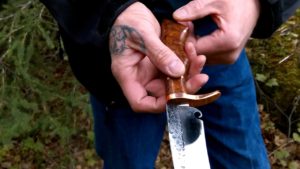
Spanish Notch in Bowie Knife
Some Bowie knives had a notch on the bottom of the blade near the hilt understood as a “Spanish Notch”. Given its not preferred by man knife experts and professionals but some bowie knives do have Spanish Notch on them, as it stops opponents blade
Thus, the Spanish Notch has the far more ordinary function as a tool for stripping sinew and repairing rope and webs, as a guide to help in honing the blade (guaranteeing that the honing process begins at a particular point and not further up the edge), or as an point where to alleviate tension on the blade during use.
Clip Point an attribute of Bowie Knife
One attribute of Bowie knives is the clip point at the top of the blade, which brings the tip of the blade lower than the spine and in line with the handle for much better control throughout thrusting attacks. As the objective is to produce a sharp, stabbing point, most Bowie knives have a bevel ground along the clip, normally 1/4 of the method, but often much even more running the entire top-edge.
This is described as an incorrect edge as from a range it looks sharpened, although it may or may not be. Despite whether the false edge is sharp, it serves to take metal away from the point, enhancing the suggestion and hence enhancing the penetration ability of the blade throughout a stab.
Following are modern clip point Bowie knives
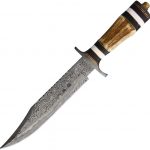
Marbles Knives Marbles Damascus Bowie (9″)
The variation attributed to blacksmith James Black had this false edge fully sharpened in order to permit somebody trained in European strategies of saber fencing to carry out the maneuver called the “back cut” or “back slash”. A brass quillon, typically cast in a mold, was attached to safeguard the hand.
Uses of Bowie Knife
The Bowie knife’s style likewise provides itself to use as a hunting knife for skinning or butchering game. The curved leading clip bevel of the blade, when suitably sharpened, might be utilized to eliminate the skin from a carcass, while the straight part of the knife’s edge can be used for cutting meat.
Following are some best Bowie Knives Available in Market

Frost Cutlery Arrowhead Bowie (6.75″)
What is James Black’s Bowie Knife?
Arkansas culturalist and researcher Russell T. Johnson describes the James Black Bowie knife in the following way and at the same time records the quintessence of the Bowie Knife: “It must be long enough to use as a sword, sharp enough to use as a razor, wide enough to utilize as a paddle, and heavy adequate to utilize as a hatchet.” Many such knives meant for hunting are only honed on one edge, to reduce the danger of cutting oneself while butchering and skinning the carcass.
Details of Designing or Variation
The most popular version of the Bowie knife was created by Jim Bowie and presented to Arkansas blacksmith James Black in the type of a sculpted wood model in December 1830. James Black forged the knife being ordered by Bowie, and at the same time created another one based upon Bowie’s original design but with a sharpened edge on the curved leading edge of the blade. Black provided Bowie his option and Bowie picked the customized variation which Black freshly forged.
Sheffield Bowie Knives
Knives such as this, with a blade shaped like that of the Bowie knife, but with a noticeable incorrect edge, are today called “Sheffield Bowie” knives, due to the fact that this blade shape ended up being so popular that cutlery factories in Sheffield, England were mass-producing such knives for export to the U.S. by 1850, normally with a deal with made from either wood, deer antler, or bone, and often with a guard and other fittings of sterling silver.
The James Black Bowie knife had a blade roughly twelve inches (30 cm) long, 2 inches (5.1 cm) broad, and 1⁄4 inch (0.64 cm) thick. The tang of the knife was covered with soft brass or silver, apparently to capture the opponent’s blade in the course of a knife battle (Spanish Notch), while a brass quillion protected the hand from the blade.
Legend of James Black Bowie Knife
In 1831 Bowie returned with his James Black Bowie knife to Texas, and was associated with a knife battle with three males armed with firearms, who had been employed to eliminate him by the man he had actually spared in his 1829 battle.
According to reports of that time, Jim Bowie utilized his knife to kill all three men:
- one assassin was almost decapitated
- second was disemboweled
- the skull of the third guy was divided open.
Bowie passed away at the Battle of the Alamo five years later on and in death both he and his knife ended up being an American legend. The fate of the original Bowie knife is unknown; nevertheless, a knife bearing the inscribing Bowie No. 1 has been obtained by the Historic Arkansas Museum from a Texas collector and has actually been credited to Black through clinical analysis.
Boom in Black’s Bowie Knife Making
Black soon had a flourishing business making and selling these knives out of his store in Washington, Arkansas. Black continued to refine his method and enhance the quality of the knife as he went.
Black’s knives were known to be exceedingly hard, yet flexible, and his method has actually not been duplicated. Black kept his method trick and did all of his work behind a leather drape. Many claim that Black rediscovered the trick of producing real Damascus steel.
Secret of Black’s Damascus Steel
In 1870, at the age of 70, Black tried to hand down his secret to the son of the household that had actually cared for him in his old age, Daniel Webster Jones. Black had been retired for numerous years and found that he himself had actually forgotten the trick. Jones would later end up being Governor of Arkansas.
The claims concerning James Black and his knives have actually been challenged by historians and knife specialists. Little can be either shown or disproved; Black was found mentally unstable before his claims were released
Birth Place of Bowie Knife
These days, Bowie Knife’s birthplace is part of the Old Washington Historic State Park which has over 40 restored other facilities and historical buildings including Black’s store. The park is referred to as The Colonial Williamsburg of Arkansas. The American Bladesmith Society established the William F. Moran School of Bladesmithing at this site to instruct new apprentices along with journeyman, and master smiths in the art of bladesmithing.
Is Bowie Knife Legal?
Many jurisdictions worldwide have knife legislation regulating the length of a blade one may carry or own, particular locations in the United States have legislation restricting or restricting the carrying of a “Bowie knife”. Each State in US has different Laws related to type, size and wearing a Knife. So, do check your Laws for buying a Bowie Knife.
As many of these laws were passed years previously, originally in the interest of managing or eliminating the then-common practice of “dueling”, a term which had actually deteriorated from a hardly ever utilized social custom into a generalized description for any knife or weapon battle between 2 participants. In some states, many of these laws are still in force today whereas, in other states, these laws were reversed or changed.
In 1837, the year after Bowie’s death at the Alamo, the Alabama legislature passed laws enforcing a $100 transfer tax on ‘Bowie’ knives and decreeing that anybody carrying a Bowie knife who consequently eliminated a person in a fight would be charged with premeditated murder. Louisiana and Virginia prohibited the concealed carrying of any Bowie knife.
When brought hidden or when utilized as a dueling weapon, while Mississippi made such knives prohibited.
In Tennessee, using Bowie knives to settle conflicts on the spot so alarmed state lawmakers that in 1838 they not just made the hidden carrying of a Bowie knife a criminal felony, but likewise restricted making use of a Bowie knife in any run-in, regardless of self-defense or other mitigating excuse:
That if anyone bring any knife or weapon called a Bowie knife or any knife or weapon that will confirm the size, or shape resemble a Bowie knife, on a sudden encounter, will cut or stab another individual with such knife or weapon, whether death takes place or not, such individual so stabbing or cutting will be guilty of a felony, and upon conviction thereof will be confined in the jail and penitentiary home of this State, for a period of time not less than 3 years, nor more than fifteen years.
In modern-day Texas, the state Jim Bowie passed away safeguarding, the carrying of a Bowie knife “on or about one’s person” in public locations was particularly managed under state law until 2017. This law has actually been changed effective September 1, 2017.
Restricted Locations of Bowie Knives
Now Bowie knives can be brought freely throughout the state, other than all knives with a blade length over 5 1⁄2 inches (14 cm) are now location-restricted knives, which cannot be carried in
- Schools
- Polling places
- Places of worship
- Amusement parks
- Courthouses
- Racetracks
- Correctional facilities
- Hospitals and nursing facilities
- Sporting events
- Any establishment (Club, Bar, Pub, Restaurant etc.) that derive 51% or more of their income from the sale of alcohol.
Where to Buy Bowie Knife?
You can buy Bowie Knife from different knife stores, or you can get it forged from knife smith. But the best option is to buy a bowie knife online these days. Because time is Money and with so many brands offering Bowie knives with experience in blade making of many years. You can buy different bowie knives on discounted prices from Chicago Knife Works as we have bowie for sale. Plus, we have more than 400 Bowie Knives for you to pick from.
Above all, you will also see Origin of Knife, meaning where its been forged (manufactured). Because of Globalization, different brands outsource their knives to China, Pakistan etc. Therefore, you as a buyer must have the information about it. We at Chicago Knife Works, provide the maximum information about our products as we buy directly from Manufacturer or from their distributor (wholesaler).
Last, WE also offer 30 days easy return / refund policy.

